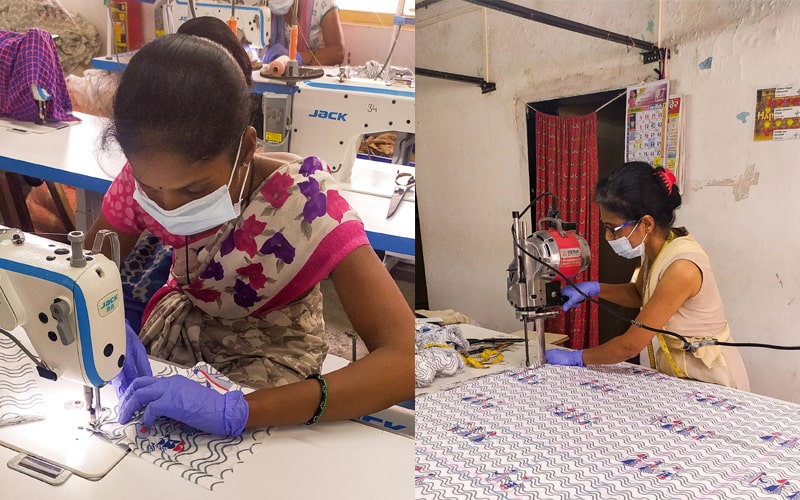Anita Dongre took to Instagram on 22 March to announce a medical fund of US $ 15 million (Rs. 1.5 crore) to support their smaller vendors, self-employed artisans, and partners who do not have medical insurance or coverage to prepare for medical emergencies arising from COVID-19.
In consideration of the coronavirus crisis, The Anita Dongre Foundation was swift to decide the set-up of this dedicated fund. The company’s direct employees already have medical insurance in place that covers them and their family members. However, in case of an additional emergency, Dongre promised that this fund was to be extended to them too. A helpline was, thus, set up to assist employees and partners to answer any queries.
Making the right move
Closely following the norms of the ongoing lockdown and WHO rules, House of Anita Dongre also announced the production of cloth masks for distribution to contribute further in the fight against COVID-19. After receiving adequate permissions from Government authorities, production of these masks was started in April across two of the five rural village centres that were initiated in collaboration with the Maharashtra State Government 4 years back, starting with Charoti. Through these centres, The Anita Dongre Foundation trains women to make garments and has set up a production facility close to their homes to bring gainful employment to them.
These centres have had voluntary participation of about 24 women who were able to create up to 7,000 masks each week for distribution to NGOs, village residents, individuals, and hospitals.
Also Read: Torqadorn by Tanvi Sethi: The prêt-à-couture push redefining power dressing in India
Keeping these initiatives in the backdrop, Apparel Resources wanted to understand further about business and how the sudden pause in business with COVID-19 has affected the brand. Yash Dongre, Business Head, House of Anita Dongre Ltd., informs us, “The lockdown has been a very challenging phase for retail. Stores were closed for around 2 and a half to 3 months, and even now, some of our mall stores are closed. Fortunately for our brand, we already had an online presence pre-COVID-19, so it was a lot easier for us to scale up. Thus, we put our whole energy there; we strengthened our business within the online space, started bringing in more technology partners to improve our customer experience, and we’ve been seeing a very healthy growth in our e-commerce numbers.”
Studying the response
Yash further explains how the consumer sentiments, especially for people who had their weddings planned, were spirited and that boosted them to stay afloat. He says, “Amidst all the gloom, there was some positive side too, people realised that this is going to be a normal thing walking ahead from here and they realised that they can’t hold back their lives forever. So, many couples still went ahead with their wedding ceremonies, especially in the US. People were having smaller ceremonies maybe at home or in their backyards, but people were still buying clothes because irrespective of where you get married, you still want to look your best. So we saw a lot of purchases for June and July, and orders for weddings that would happen at the end of this year or early next year. The bridal business is still looking promising, but the ready-to-wear category is seeing some business online. The store footfall is very poor and we’re expecting an increase for the festive season.”
Business in the time of the pandemic
“For a business like ours that is primarily an offline one, going online has its fair share of challenges. For us, our number one priority was to offer an omnichannel experience to the consumer because wherever the customer is ordering from, the experience should be seamless. We were having some difficulty earlier this year with the whole backend omnichannel framework, for which we now have some technology in place to offer a seamless backend experience,” Yash mentions, informing about the brand’s foray into the omnichannel domain.
In keeping with the new normal, House of Anita Dongre, for the first time, held a virtual Trunk Show and prioritised video call bookings to connect with the customers. Yash mentions that each of their stores all across the globe has a ‘top 100 customer’ list, and from the beginning of the lockdown, the store team was informed to connect with this coveted customer base virtually and that has been contributing to 40-50 per cent of the sales. “Our inventory is just lying in the stores and virtual sales will continue for the next few months until the customer is confident enough to walk into a store,” Yash adds.
Also Read: How Nachiket Barve became a top Indian fashion designer
Looking ahead
“The rules of fashion won’t apply for another year, I think, and COVID-19 was the time when we were just starting with our summer collection, but we had to shut stores just then. The entire summer collection went for a toss. And now, we have reopened at a time when we have the end of season sale, so what we and a lot of other brands have done is carry forward a lot of our style to the next season, and we pushed a lot of the styles we couldn’t introduce in summer to the Fall/Winter. We’re cutting down on production because the demand is going to be 40-50 per cent lesser than the usual demand until December this year, and I think things will only get back to normal around Fall/Winter 2021,” Yash mentions while forecasting the market ahead.
When asked about the price tag and whether they had to revisit it given the lower incomes and prevailing uncertainties, Yash shares, “If you compare us to our competitors and see the landscape, fortunately we are a very reasonably priced brand and we have a huge ready-to-wear line that you’ll not see in a lot of other designer brands. We have got the pricing right from the beginning. But as you said, incomes will go down, so we’re looking to do more low price styles in our ready-to-wear line and also add to our Rs. 50,000-75,000 lehengas. Again, not many designer brands have lehengas under Rs. 1 lakh, but if you are a friend or a family member of the bride or groom, you wouldn’t want to spend so much on a lehenga, especially given the situation we are facing at present. Keeping these facts in mind, we’re looking to add lehengas, saris and suits to that line. I think that’s a very sweet price point and we’ll keep adding to that.”
Until a cure or a vaccine is introduced, Yash says business will be shaky. “We still feel very confident about Spring/Summer 2021. For the current financial year, we’ll be seeing around 50-60 per cent of last year’s numbers, but come next financial year, if not growth, we will at least go back to last year’s numbers,” Yash ends on a hopeful note.
Also Read: ALL2DEFY: How Ananya Modi Jain’s urbanwear label is defying the state of Indian fashion









